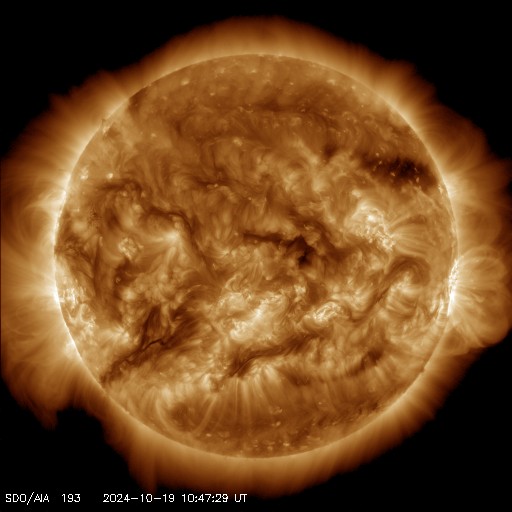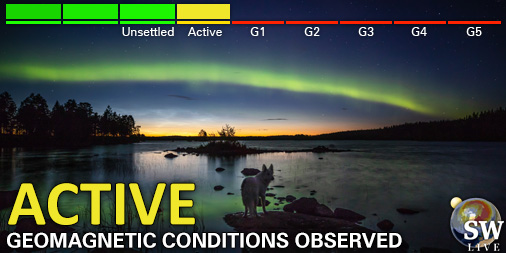Het archief bekijken van zaterdag 5 april 2003
Activiteitenrapport
Opgemaakt door de NOAA © SWPC en verwerkt door Poollicht.be
USAF/NOAA rapport van de zonneactiviteit en geofysische activiteit
SDF Nummer 095 gepubliceerd omstreeks 2200Z op 05 Apr 2003IA. Analyse van de actieve zonneregio's en zonneactiviteit van 04-2100Z tot 05-2100Z
IB. Voorspelling zonneactiviteit
IIA. Samenvatting geofysische activiteit 04-2100Z tot 05-2100Z
IIB. Voorspelling geofysische activiteit
III. Kans zonnevlammen van 06 Apr tot 08 Apr
| Klasse M | 35% | 25% | 30% |
| Klasse X | 10% | 05% | 05% |
| Proton | 10% | 05% | 05% |
| PCAF | green | ||
IV. Penticton 10.7 cm Flux
Geobserveerd 05 Apr 137 Voorspeld 06 Apr-08 Apr 135/130/120 90 dagen gemiddelde 05 Apr 135
V. Geomagnetische A index
Geobserveerd Afr/Ap 04 Apr 013/026 Geraamd Afr/Ap 05 Apr 020/025 Voorspeld Afr/Ap 06 Apr-08 Apr 015/015-012/015-015/015
VI. Kansen op geomagnetische activiteit van 06 Apr tot 08 Apr
| A. Gemiddelde breedtegraad | |||
|---|---|---|---|
| Actief | 45% | 40% | 35% |
| Kleine storm | 15% | 15% | 10% |
| Zware-ernstige stormcondities | 10% | 10% | 05% |
| B. Hoge breedtegraad | |||
|---|---|---|---|
| Actief | 45% | 40% | 35% |
| Kleine storm | 15% | 15% | 10% |
| Zware-ernstige stormcondities | 10% | 10% | 05% |
Alle tijden in UTC
<< Keer terug naar de dagelijkse overview pagina
Op basis van de huidige parameters is er in de nabije toekomst een beperkte kans op poollicht op de volgende locaties van de hoge breedtegraad
NorilskLaatste nieuws
Laatste forumberichten
Steun Poollicht.be!
Veel mensen komen naar Poollicht.be om de zonneactiviteit te volgen of om het poollicht te zien, maar met meer bezoekers komen er hogere kosten bij om de servers online te houden. Als je Poollicht.be leuk vindt en het project wilt steunen, kun je kiezen voor een abonnement op een advertentievrije website of een donatie overwegen. Met jouw hulp kunnen we Poollicht. be online houden!
Laatste alerts
12:51 UTC - Zonnevlam
Matige M2.02 zonnevlam
12:30 UTC - Radio blackout
Kleine R1 radio blackout gedetecteerd (≥M1 - momenteel: M1.35)
03:55 UTC - Coronaal gat
Een transequatoriaal coronaal gat is momenteel naar de Aarde gericht. Een verhoogde zonnewind kan in ~3 dagen aankomen op Aarde
woensdag 8 oktober 2025
06:45 UTC - Geomagnetische activiteit
Actieve geomagnetische condities (Kp4) Drempel bereikt: 05:32 UTC
dinsdag 7 oktober 2025
22:00 UTC - Type II radioemissie
Starttijd: 07/10/2025 20:07 UTC Geschatte snelheid: 755km/sec.
Ruimteweer feitjes
| Laatste X-klasse uitbarsting | 19/06/2025 | X1.9 |
| Laatste M-klasse uitbarsting | 09/10/2025 | M2.0 |
| Laatste geomagnetische storm | 03/10/2025 | Kp5 (G1) |
| Zonnevlekkenloze dagen | |
|---|---|
| Laatste zonnevlekkenloze dag | 08/06/2022 |
| Maandelijks gemiddeld zonnevlekkengetal | |
|---|---|
| september 2025 | 129.8 -3.7 |
| oktober 2025 | 131 +1.2 |
| Afgelopen 30 dagen | 130.2 -1.1 |








